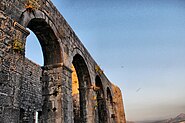Rozafa castle (Albanian: Kalaja e Rozafës/Kalaja e Rozafatit) is a castle near the city of Shkodër, in northwestern Albania. It rises imposingly on a rocky hill, 130 metres above sea level, surrounded by the Bojana and Drin rivers. Shkodër is the capital of the District of Shkodër, and is one of Albania's oldest and most historic towns, as well as an important cultural and economic centre.
Due to its strategic location, the hill has been settled since antiquity. It was an Illyrian stronghold until it was captured by the Romans in 167 BC.[1] The 19th-century German author and explorer Johann Georg von Hahn suggested that the ancient and medieval city of Shkodër was located immediately south of the Rozafa hill, between the hill and the confluence of Bojana and Drin. The fortifications, as they have been preserved to date, are mostly of Venetian origin.[2] The castle has been the site of several famous sieges, including the siege of Shkodra by the Ottomans in 1478 and the siege of Shkodra by the Montenegrins in 1912. The castle and its surroundings form an Archaeological Park of Albania.
Legend[]
Its legend, archeology and history testify to its early existence. The legend, first recorded in the Serbian epic poem The Building of Skadar,[3] is about the initiative of three brothers of the House of Mrnjavčević who set about building the castle.[4] They worked all day, but the walls fell down at night. They met a clever old man who advised them to sacrifice someone so that the walls would stand. The three brothers found it difficult to decide whom to sacrifice. Finally, they decided to sacrifice one of their wives who would bring lunch to them the next day. So they agreed that whichever of their wives was the one to bring them lunch the next day was the one who would be buried in the wall of the castle. They also promised not to tell their wives of this. The two older brothers (King Vukašin and Ban Uglješa), however, explained the situation to their wives that night, while the honest youngest brother (Voivoda Gojko) said nothing. The following afternoon, the brothers waited anxiously to see which wife was carrying the basket of food. It was Rosafa, the wife of the youngest brother. He explained to her the agreement that they had made, namely that she was to be sacrificed and buried in the wall of the castle so that they could finish building it. She did not protest.
The faithfulness of the youngest brother and the life sacrifice of his young wife are portrayed as elements of symbolic importance. Rosafa, who was predestined to be walled in, worried about her infant son, accepted to be walled in on condition that they leave her right breast exposed to feed her newborn son, her right eye to see him, her right hand to caress him and her right foot to rock his cradle. It is said that milk still flows from one of the walls in the castle.[citation needed]
References[]
| Wikimedia Commons has media related to Rozafa. |
- ↑ A. Evans et al., Ancient Illyria: An Archaeological Exploration, 2006, p 83
- ↑ J.G. von Hahn, Albanesische Studien, Jena 1854, pp 94-96.
- ↑ Alan Dundes (1996). The Walled-Up Wife: A Casebook. Univ of Wisconsin Press. pp. 146. ISBN 978-0-299-15073-0. http://books.google.com/books?id=MDmGX5y40IwC&pg=PA3. Retrieved 1 March 2013.
- ↑ Schwandner-Sievers, Stephanie; Fischer, Bernd Jürgen (2002-09-30). Albanian identities: myth and history. Indiana University Press. ISBN 978-0-253-34189-1. http://books.google.com/books?id=oRASDq3rc-YC. Retrieved 23 September 2010.
External links[]
The original article can be found at Rozafa Castle and the edit history here.





